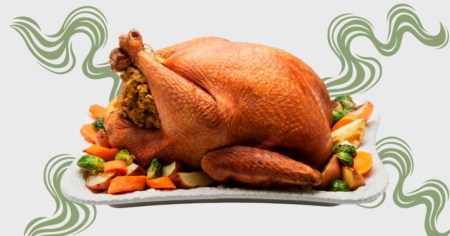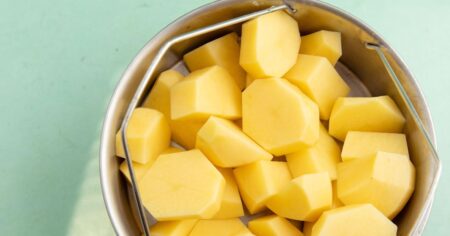Apple, pumpkin, pecan and sweet potato pie have become staple desserts on Thanksgiving tables across the U.S. But there are seemingly endless local and regional pies enjoyed by Americans on Turkey Day and even year round.
One of the more interestingly named examples is “shoofly pie.” Although it’s not traditionally served at holidays, Google data revealed that shoofly was in fact the most uniquely searched pie in Pennsylvania around Thanksgiving last year.
You might not have heard of this confection if you didn’t grow up around southeastern Pennsylvania, but that doesn’t mean you can’t appreciate the sugary treat. Below, experts break down what goes into making a delicious shoofly pie and how its name came about.
What is shoofly pie?
“Shoofly pie is a molasses crumb cake baked in a pie crust,” William Woys Weaver, an expert in Pennsylvania Dutch cuisine and culture and author of “As American as Shoofly Pie,” told HuffPost. “It consists of molasses mixed with baking soda on the bottom. Crumbs made from butter and flour, a little brown sugar, and your spices of choice ― usually nutmeg ― are sprinkled over this. This is then baked in a hot oven for perhaps 15 minutes, then the heat is reduced. The molasses mixture foams up and forms a cake.”
The result is a rich pie-cake hybrid that’s gooey in the center but easy enough to eat with your hands or a fork thanks to its flaky crust exterior.
“Shoofly pie is a classic Pennsylvania Dutch pastry,” said Mark Louden, a professor of Germanic linguistics and director of the Max Kade Institute for German-American Studies at the University of Wisconsin–Madison. It’s an “apt symbol of traditional Pennsylvania Dutch culture as it incorporates elements from Old World Europe but is a fundamentally New World phenomenon.”
To this day, the regional speciality is typically associated with the Moravian, Mennonite and Amish communities of Lancaster County.
“Shoofly pie is a coffee cake normally consumed at breakfast or as a snack during breaks,” Weaver explained. “The Pennsylvania Dutch baked the cake in a crust ― their innovation ― so that it could be eaten out of hand as one dipped it into coffee. Some people broke up the pie into their coffee and called it ‘coffee soup.’ That mushy mixture may be an acquired taste.”
You can make a shoofly pie with a “wet bottom” or “dry bottom.” In the wet version, the molasses filling soaks into the pie crust, resulting in more of a moist bottom layer and a consistency that you might compare to a sticky toffee pudding or custard.
The dry bottom version is baked to more of a cake-like consistency with a denser filling that might separate more easily from the crust (and dip more nicely into coffee). To achieve this texture, you can mix the molasses filling with some of the crumb topping before pouring it into the pie crust and then sprinkle on the rest of the crumbs.
You can choose to incorporate spices into your shoofly pie or not, but the molasses, brown sugar, flour, butter and baking soda are staples. Modern versions might include eggs or an extra topping of chocolate icing.
Buyenlarge via Getty Images
What’s the origin of this pie ― and its name?
“The precise origins of shoofly pie are obscure, but it has elements of traditional German streusel-topped cakes that were eaten for breakfast and not as a dessert,” Louden said. “It was originally made during the winter months, when molasses could be stored at cool temperatures without fermenting.”
In his research on Pennsylvania Dutch cuisine, Weaver has traced shoofly pie’s development back to the period just after the Civil War. He notes that the dish was initially described as “centennial cake.”
“It first appeared at the U.S. Centennial in 1876 at the Centennial Restaurant, which was the German restaurant on the fairgrounds” in Philadelphia, Weaver told HuffPost. “Centennial cake was essentially shoofly pie baked as a cake ― no crust.”
The addition of the pie crust came not long after, as did the name “shoofly pie,” which historians believe originated in the 1880s.
“The name likely derives from Shoo-fly Molasses, which was produced in Philadelphia and named for Shoofly the Boxing Mule, a circus animal popular in 19th century Pennsylvania,” Louden said.
Weaver included an image of this legendary creature in his boxing mode circa 1880 in his book “Dutch Treats: Heirloom Recipes From Farmhouse Kitchens.”
“Shoofly the Boxing Mule was a feature in a local circus and became something of a folk legend in the Dutch Country,” he said. “I do not know who owned Shoofly or what happened to him, but I am sure those answers are buried somewhere in local newspapers of the period.”
The mule’s name might have been inspired by a song that dates back to the mid-19th century, “Shoo Fly, Don’t Bother Me.” The term “shoo-fly pie” itself went on to feature prominently in Dinah Shore’s hit 1940s song “Shoo-Fly Pie and Apple Pan Dowdy.”
“The Pennsylvania Dutch name for shoofly pie is melassich riwwelkuche, which translates directly as ‘molasses crumb cake,’” Louden noted.
Another popular theory surrounding the origin of the name involves the fact that much of Pennsylvania Dutch baking at that time took place outdoors. As a result, so the legend goes, the sweet molasses-filled pie attracted flies, and bakers would need to shoo them away during the cooling process.
Where can you get shoofly pie today?
“Shoofly pie is widespread in the traditional Dutch Country of southeastern Pennsylvania and consumed by residents and visitors alike,” Louden said. “Pennsylvanians are most likely to still eat it mostly for breakfast, often with coffee, but it is now popular as a dessert, too.”
Many families in the region have shoofly pie recipes that have been passed down for generations.
“It was then and still is today a basic coffee cake throughout the Dutch Country and is available for sale in most farmers markets and even in some local food stores,” Weaver said.
We Need Your Support
Support HuffPost
Already contributed? Log in to hide these messages.
You can find shoofly pie at bakeries in Lancaster County and other areas with a strong Pennsylvania Dutch presence. Non-locals can also order one for delivery thanks to services like Goldbelly.
“It is not a special occasion dessert, so I doubt many people serve it at Thanksgiving, although there may be exceptions since it is a matter of personal taste,” Weaver said, adding that one particular Pennsylvania Dutch segment — the Amish — are more likely to view pizza as a special treat.
Still, there’s no reason to believe shoofly pie couldn’t one day have a bigger presence on Thanksgiving tables across the U.S. thanks to its sugary taste and symbolic blending of Old World and New World cuisine.
As Louden noted, “All major expressions of Pennsylvania Dutch life, including the language, traditional values, material products and foodways, are hybrid and thus quintessentially American.”
Read the full article here








